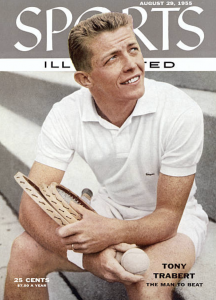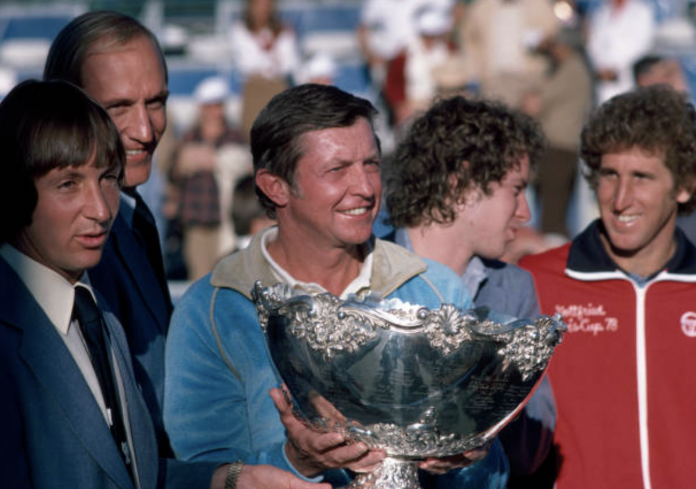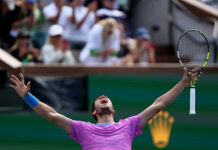Bill Simons
Like the late Ohio Bear, Barry MacKay, Tony Trabert was a Buckeye. Like the University of Cincinnati hoopster Oscar Robertson, Trabert was a Bearcat. Both he and the basketball legend were stars for the University of Cincinnati. More than this, Tony “the Tiger” Trabert was a lion. In the mid 50s he led the American pack. Then he went on, like the sparrows of Capistrano, to become a beloved regular in our tennis lives. For 31 years, in the last glorious days of summer, fans were delighted when he’d come on the air once again to broadcast the US Open. There have been few more satisfying tennis rituals than listening to Trabert analyzing the Open on CBS. His voice had depth, his knowledge was deeper. We sensed his love of the game.
With just a handful of others (Marty Reissen, John Lucas, Mardy Fish and Rick Barry) he excelled at both tennis and basketball. In 1951 he was an All-American hoopster. Then he went on to win the collegiate tennis championships. Long before names like Smith and Ashe or Connors and McEnroe grabbed headlines, Trabert was the face of American tennis in the mid-50s.
Tennis is a sport of barrier breakers, and Marion Anthony Trabert was very much a part of that narrative. There’s a long, dismal history of Americans flailing at the French Open – Kramer, Gonzales, Smith, Ashe, McEnroe, Connors, Sampras and Roddick all fell short on Paris’ sticky clay.
But not Tony. He won Roland Garros in 1954 and again in 1955. No American would win there again until Michael Chang prevailed in 1991. Rod Laver and Don Budge each won four majors in a year. Just below them, Trabert had what Bud Collins called “one of the finest seasons ever achieved.” In 1955 he did what no other American has done since Budge. He became a “tripler,” as he captured three majors – The French, Wimbledon and the US Nationals. In 2019 Wimbledon winner, Novak Djokovic, banked almost $3 million. Tony’s Wimbledon prize was a $27 gift certificate redeemable in just one London sporting goods store.
In 1955 the ascendant American had a 105-7 record and was No. 1 in the world. He had a 36-match winning streak, won 18 singles tourneys and, with his Davis Cup partner, Vic Seixas, won 12 doubles titles. No other modern American – not Kramer, McEnroe, Connors, Sampras or Agassi – ever had a year like Tony’s ‘55 season.
In those days, Australia, with players like Lew Hoad and Ken Rosewall, dominated the critically important Davis Cup. But Trabert broke that barrier too. In 1954, with Seixas, he brought down the Aussies down under. Late in 1955 he turned pro, having notched five singles and five doubles majors. When he reached a major singles final, he never lost. In 1979 Jack Kramer ranked Trabert among the best 21 players of all time.
A patriot and a Navy veteran, Tony had a great backhand, strong groundies, superb volleys and an aggressive game. So perhaps it’s not shocking that when he became America’s Davis Cup captain, the man with an attacking tennis game attacked anti-apartheid protestors with his racket when they poured motor oil on a Davis Cup court in Newport Beach. After the protesters were arrested and taken away in handcuffs, Trabert explained, “I had some athletes out there (Stan Smith and Bob Lutz) and I went out to protect them.” When the protesters returned the next day, Trabert again weaponized his racket.
As America’s Davis Cup captain, Tony dealt with a new generation of rebels (think McEnroe and Connors) and led the US to titles in 1978 and 1979. And for three decades after his playing days, the son of a GE engineer engineered an exemplary off-court career. He did it all with class and grace. He not only got into the International Hall of Fame – for a decade he was their president. With his son Mike ran a popular camp in Ojai and Pebble Beach that inspired thousands. He was an author, a motivational speaker, and a patriarch who had two children, 3 stepchildren, 12 grandkids and 3 great grandkids. His granddaughter Brittany has long been a respected marketing executive for the BNP Paribas Open.

Billie Jean King told Inside Tennis, “I’m deeply saddened to learn of the passing of my hero Tony Trabert. He was the first athlete I asked for an autograph and I remember that moment at the Los Angeles Tennis Club where he took the time to speak with me. Over the years our relationship grew deeper and he was a wonderful mentor in tennis, in broadcasting and in life. We even won a doubles title together in 1975 in Scottsdale, defeating Margaret Court and Frank Sedgman, 6-4, 6-2, earning Tony the biggest tennis paycheck of his storied career. He was a legend, a friend, and I will miss him. “
Current Hall of Fame President Stan Smith noted, “Tony was not only a terrific example on how to be a great champion, but was also a wise coach and mentor, a fair and effective leader, someone who gave back to the sport and was a terrific ambassador.”
To most, Trabert will be recalled as the man who provided on-air insight into America’s greatest tournament. From 1971 to 2004, the US Open wasn’t the Open if Trabert didn’t note that the great Pancho Segura was sitting courtside watching some critical match.
The man who came from a working class family and started on public clay courts in Ohio, became the leading light of American tennis in the 50s, and until yesterday that light never went out. Simply put, the man who received a $27 gift certificate for winning Wimbledon was a gift to our game. After all, Tony “the Tiger” Trabert was a lion.



















